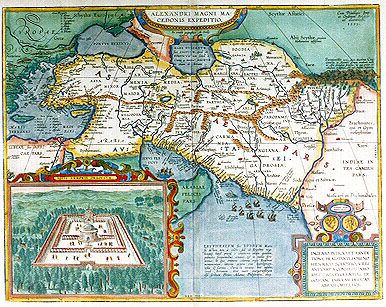Cartographica Neerlandica Background for Ortelius Map No. 222

Title: ALEXANDRI MAGNI MA:|CEDONIS EXPEDITIO. | "Ex conatib. geographicis A. Ortelij". [The expedition of Alexander the Great, based on the geographical efforts of Abraham Ortelius]. (Upper right:) "Cum Priuilegio Imp. | et Ordinum Belgicor. | ad decennium. | 1595". [With a privilege of the emperor and of the Belgian authorities for ten years. 1595. (Cartouche lower right corner:) INGENIO, IVDICIO, ET ERVDI:|TIONE PRÆSTANTI, DOMINO | HENRICO SCHOTIO, VRBI | ANTVERP. A CONSILIIS: AMO:|RIS ET BENEVOLENTIÆ ER:|GO, HANC TABVLAM DEDICAB. | ABRAH. ORTELIVS. [Abraham Ortelius has dedicated this map to the learned, considerate and highly erudite lord Henricus Schotius of the city of Antwerp for his advice, friendship and benevolence]. (Inset, 140 x 192 mm:) IOVIS AMMONIS ORACVLVM. [the oracle of Jupiter of Ammon]. (Bottom right:) ERYTHRAEVM "sive" RVBRVM "Mare, | sic dictum non à colore; sed ab Erythro rege. | Extatque haud procul à continenti insula quædam, palmetis frequentibus consita, & in medio fere | nemus, in qua eminens columna regis Erythræi | monumentum, litteris gentis eius inscriptum. | testis Q. Curtius. Oaracta vocatur hæc insula, | apud Arrianum. Hoc mare margaritiferum | esse scribunt Plinius, Aelianus, Philostratus alijq". [Erythraeus or the Red Sea, so called not after its colour, but after king Erythrus. There is here not far from the main land an island rich in palm trees, and about in the middle there is a forest with a splendid column in the memory of the Erythraean king, with letters carved into it by his people, as Quintus Curtius testifies. This island is called Oaracta by Arrianus. This sea brings forth pearls, according to Plinius, Ælianus, Philostratus and others]. (Top right:) Paropamisus "mons, quem Macedones Cau:|casum in Alexandri gloriam vocabant. nulli | in Asia altitudine secundus, in quo præter Terebintum et silphium, nihil nasci, tradidit Aristobulus". [Mount Paropamisus, which the Macedonians call Caucasus to honour Alexander the Great. In height it is second to none in Asia, and except for terpentine trees and silphium (silphion or laser, an extinct plant species of the genus Ferula, rare and supposed to be of medicinal value) nothings grows here, as Aristobulus says]. (More text blocks in Topographical Names).
Plate size: 364 x 464 mm.
Scale: 1 : 14,000,000
Identification number: Ort 222 (Koeman/Meurer: 31P, Karrow: 1/206, van der Krogt AN: 8030H:31).
Occurrence in Theatrum editions and page number:
1595L5Addblank (100 copies printed) (text and typesetting identical to 1595L, but without page number; last line first text page: quoque hic habeo Tzetzam Chiliade 6.numero 64. vbi tradit eam de die lætum cantum , noctu autem flebile carmen canere , è Calliste hoc ),
1595LY (500 copies printed) (text and typesetting identical to 1595L5Add, but here with page number Y; last line first text page: quoque hic habeo Tzetzam Chiliade 6.numero 64. vbi tradit eam de die lætum cantum , noctu autem flebile carmen canere , è Calliste hoc ),
1597G5Addblank (75 copies printed) (identical to 1602G, but here without a page number; last line, full width, in Gothic script: hat auch/wie Dacius schreibt der Keyser sonderlich betrachtet/und der Keiser Sept. Seuerus mit fleiß beschawet/wie Spartianus meldt.),
1601Lxxxij (200 copies printed) (last line first text page, right aligned: MEMNO- ; last line second text page, left aligned: mon (quod multitudinem significatiuè ex Hebræo transferunt) huius loci proprium sit nomen.),
1602G29 (250 copies printed) (last line, full width, in Gothic script like the entire text: hat auch/wie Dacius schreibt der Keyser sonderlich betrachtet/und der Keiser Sept. Seuerus mit fleiß beschawet/wie Spartianus meldt.),
1603L rarely xxxij or mostly xxxiiij (300 copies printed) (text and page number, but not typesetting, identical to 1609/1612S/L; last line first text page, right aligned: MEMNO- ; last line, second text page, left aligned, above 8 coins: ex Hebraeo transferunt ) huius loci proprium sit nomen.),
1606Exxxij (300 copies printed) (last line, first text page of two, full width: this is beside our purpose. It remaineth only that we speake a word or two of "Memnon", which, Quintus Curtius reporteth, Alexander had a great desire to see. In | the ),
1608/1612Ixxxiiij (300 copies printed) (last line first text page, right aligned: desma ; last line second text page, left aligned in small font: moltitudine con vero significato ) esser di questo luogo il proprio nome.),
1609/1612Sxxxiiij (text in Latin) = 1609/1612Lxxxiiij (600 copies printed) (last line, first text page, below four copper coins, right aligned: MEMNO,; last line, second text page, left aligned, above 8 coins: Verisimile itaque Ammon (quod multitudinem significatio ex Hebræo transferunt)huius loci proprium sit nomen.),
1624LP/1641Sxxxviij (1025 copies printed) (last line first text page second column, right aligned: ris ; last line second column second text page, left aligned: transferunt) huius loci proprium sit nomen.).
Approximate number of copies printed: 3650.
States: 222.1 as described; fifth line of text block bottom right centre in the sea reads: "nemus; in qua eminens columna regis Erythræi";
222.2: in 1601, "Pilora" in Persian gulf changed to "Pylora";
222.3, in 1624, fifth line in the sea now reads: "nemore columna eminet regis Erythri". "Cythuos" in upper left corner changed into "Cythnos". "Arrh. in Indicis" just above fleet changed into "Arr. in Indicis".
Cartographic sources: numerous classical authors, specifically Archelaus, Diogenes Laërtius, Plinius, Ptolemæus, Diodorus, Plutarchus and Livius.
Remarks: the inset shows the oracle of Jupiter Ammon, supposedly situated in present day Libya, where Alexander went to ask what would be the result of his expedition. He also expressed the desire to be buried there, but was eventually buried in Alexandria in Egypt. Ortelius derives his information on the oracle from Lucretius, Solinus, Ovidius, Lucanus and many others. He complains that more attention is paid by classical authors to Alexander's personal habits, than to the regions and territories he conquered, but restricts his own discussions to the two Iupiter Ammon temples and statues, and does not discuss Alexander's travels.
For questions/comments concerning this page, please e-mail info@orteliusmaps.com.